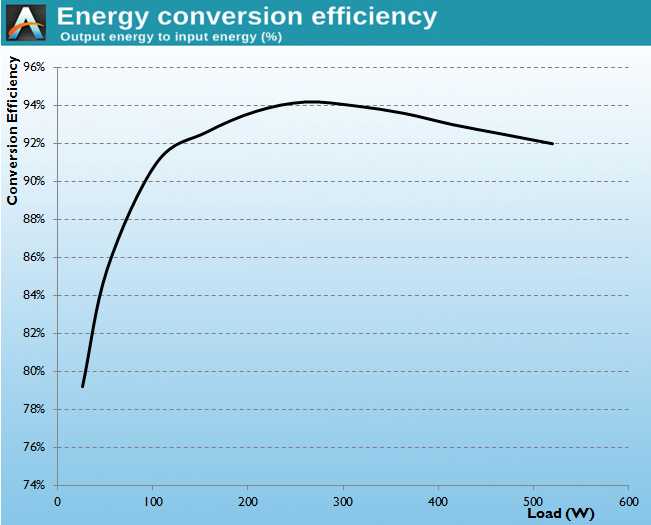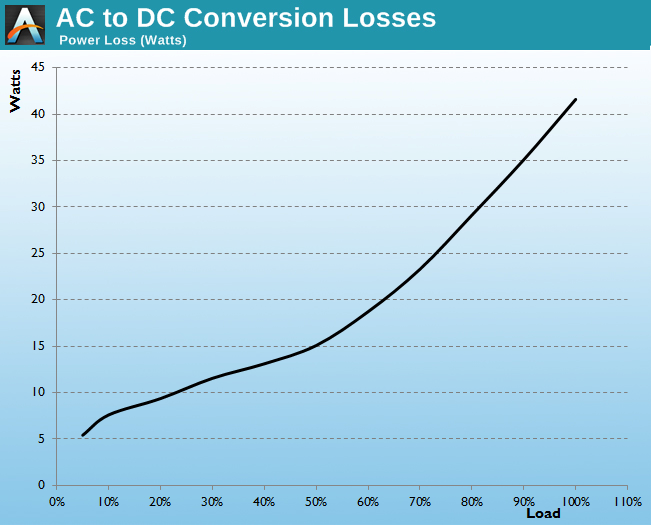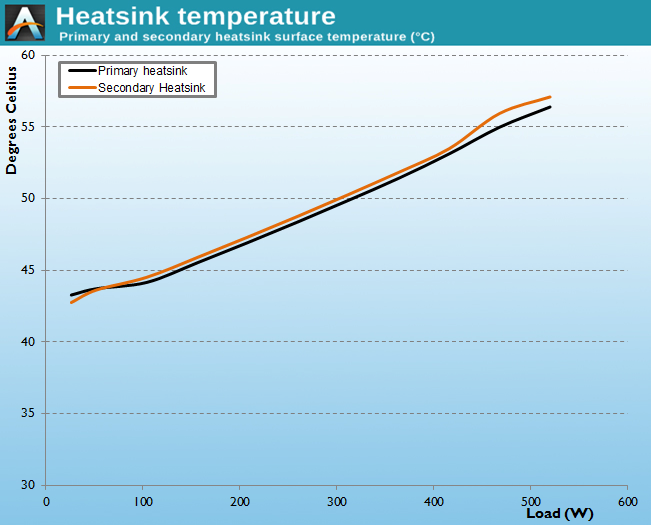SilverStone NightJar NJ520 Power Supply Review
by E. Fylladitakis on July 8, 2014 6:00 AM EST- Posted in
- Cases/Cooling/PSUs
- Seasonic
- PSUs
- Fanless
- SilverStone
Cold Test Results
For the testing of PSUs, we are using high precision electronic loads with a maximum power draw of 2700 Watts, a Rigol DS5042M 40 MHz oscilloscope, an Extech 380803 power analyzer, two high precision UNI-T UT-325 digital thermometers, an Extech HD600 SPL meter, a self-designed hotbox and various other bits and parts. For a thorough explanation of our testing methodology and more details on our equipment, please refer to our How We Test PSUs - 2014 Pipeline post.
Since this power supply is fanless, we are going to have two fewer graphs in this review. The first one is the noise chart, as this product has no moving parts and thus does not generate any noise, and the second one is the air temperature chart, as this method cannot be accurately applied if there is no forced airflow.
The electrical performance of the Nightjar NJ520 is excellent, which was to be expected from a Seasonic design. At room temperature, the Nightjar NJ520 easily meets the 80Plus Platinum certification and displays an average energy conversion efficiency within the nominal load range (20% to 100%) of 93.0%. Loads lower than 50 Watts however have a significant impact on the efficiency, which drops below 80%. This does not affect the 80Plus certification, which takes into account only the 20% to 100% nominal capacity range.
Even though it is a very efficient model, the Nightjar NJ520 remains surprisingly cool for a passive power supply, with the temperature of the primary and secondary heatsinks reaching up to 56.4 °C and 57.0 °C respectively. Although these figures are relatively high for a 520 Watt model in room temperature, the Nightjar has no forced cooling and therefore it is perfectly natural for it to be warmer than typical units.













44 Comments
View All Comments
hybrid2d4x4 - Thursday, July 10, 2014 - link
Agree. I got a Seasonic 400 Platinum Fanless model to run an upper-midrange gaming rig/HTPC, and it never gets more stressed than 60% of its rated power (measured at the wall, not internally). Short of some picoPSU units with minimal power regulation, there isn't anything out there that's a good match for a 'typical' integrated video system and there should be!Cygni - Tuesday, July 8, 2014 - link
The more fanless/silent part reviews, the better. Maybe I'm just old now, but I refuse to have a big leaf blower of a computer in every room anymore, even for my gaming computer. It's 2014!Really interested in this part. Think it will go well with my new low heat gaming build. More silent/quiet reviews please!
Spoogie - Tuesday, July 8, 2014 - link
Not really sure I'd buy this over the Kingwin. I have the 1k version of the Kingwin and it's truly silent with no elec noise at all and a 5 year warranty.http://www.silentpcreview.com/Kingwin_Lazer_Platin...
johnny_boy - Tuesday, July 8, 2014 - link
Why don't they build "dual PSUs" that combines a low wattage psu (max 10W) with a higher wattage psu such that it switches to the low one when the computer is in standby and switches back to the higher wattage one when powered up. A standard desktop PSU must be massively ineffecient when powering a computer on standby.DanNeely - Tuesday, July 8, 2014 - link
I think VStandby is on a separate circuit; JonhyGuru does test it. Looking a pair of recent reviews, one that was slammed as the worst they'd seen in a long time was only ~70% efficient; but that's still only a few watts of wastage even at max load. And while I've never measured it, I'd expect standby power to be at the low end of the draw range except when you hit the power button and trigger the first part of the resume sequence or if you have and are using USB charging from an otherwise offline system.E.Fyll - Wednesday, July 9, 2014 - link
Because that would either increase the cost of the unit dramatically or result to a less efficient configuration. Besides, the difference between the least efficient and the most efficient PSU at standby is just a few cents per annum from an economic point of view. Improving the efficiency of the PSU at such low a load has zero actual purpose, therefore the companies are sticking to meeting the base guidelines rather than wasting resources and increasing the cost of their products to do that.lucyfek - Tuesday, July 8, 2014 - link
Does the fanless PSU really matter (besides for the pricetag)?Once you realize that decent PSU with 120mm slow fan is barely audible (definitely quieter than average CPU or GPU). Besides that you'll need to evacuate the heat out of the case somehow.
I did have 2 fanless PSU back in the day. Was my PC really quiet because of that - nope.
mapesdhs - Wednesday, July 9, 2014 - link
See my earlier post for a longer suitable reply, but basically, supposedly quiet PSUs
are usually not at all quiet, hybrid PSUs are poor quality, and heat rises. The PSU
I bought had a big label & notice inside making it very clear how it should be used
to ensure proper natural convective airflow.
Ian.
viharm - Wednesday, September 4, 2019 - link
Completely agree with @mapesdhs. I am following a similar path to my custom home NAS build.viharm - Wednesday, September 4, 2019 - link
It matters very much when you start taking other noisy parts out of the system. I am going fanless, so the PSU fan becomes the loudest part :-)